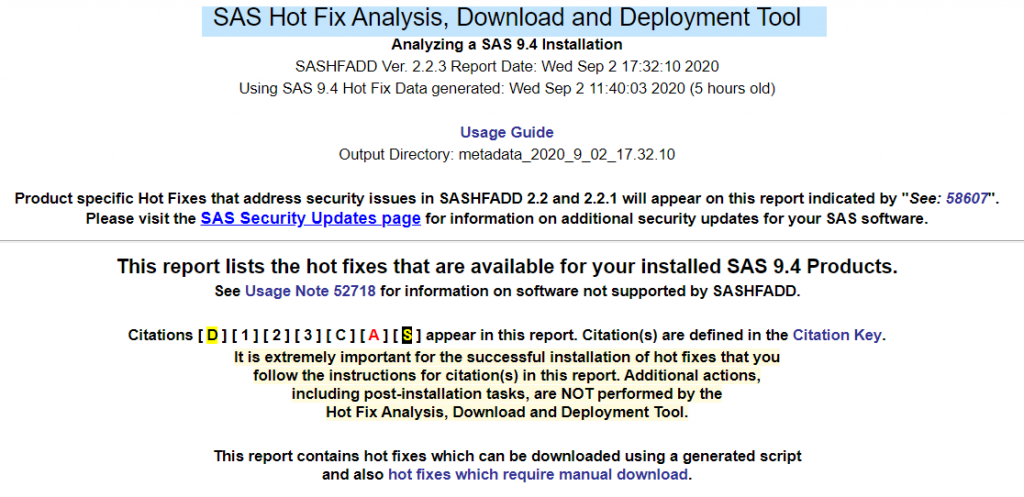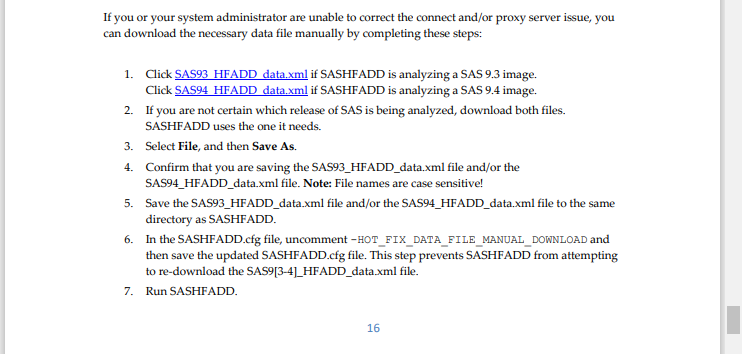This is the second of three posts on our hot-fix process, aimed at helping you better manage your SAS®9  environment through tips and best practices. The first, an overview of the SASHFADD tool, is linked here and at the end of this post.
environment through tips and best practices. The first, an overview of the SASHFADD tool, is linked here and at the end of this post.
Having a good understanding of the hot-fix process can help you keep your SAS environment running smoothly. This second installment aims to help you understand hot-fix dependencies by giving you a sneak peek into the report generated by the SASHFADD tool.
SASHFADD tool report
Here's what the SASHFADD tool report looks like:

The citation key for items in the report is listed at the bottom of the page. This blog takes you through an example report for the SAS middle tier to show you how the citation key (shown below) works. For full details about the items in the citation key, see the SAS Hot Fix Analysis, Download and Deployment (SASHFADD) Tool Usage Guide.

My report, SAS Middle Tier 9.4_M6 for Windows for x64, shown in the display below contains the following:
- [1] for Issues Addressed
- [A] for Alert
- [C] for Container
- [D] for Documentation
- [S] for Security

What do the citations mean to you? Well, you need to click the citations to get a bigger picture of what this hot fix contains. Let's examine each citation in my example report in detail.
Citation key example
When you click the [1] for Issue(s) Addressed, it takes you to a page that lists all the SAS Notes that are being addressed in the fix:

If you scroll to the bottom of that section, it shows you whether there are other hot-fix dependencies or requirements that you need to meet before installing this hot fix. In this example, it shows that you must also install Hot Fix E3I012.

In the list of SAS Notes, any alert SAS Notes are labeled with ALERT. This report includes an [A], and you can see the alert SAS Note marked in the list. This citation is helpful if you want to update your system only for critical issues. If that is your preference, there is a SASHFADD script that will automatically download only the alert hot fixes and any corresponding dependency hot fixes.
The [C] in the report shows that it is a container hot fix. This citation is not clickable; it is there to indicate that you should refer to the documentation for a list of hot fixes in the container. When you click the [D], you see any relevant installation instructions. This page also lists the "member" hot fixes of the D8T013 "container" hot fix:

This page includes important notes along with installation instructions, and sometimes also includes pre-installation and/or post-installation instructions.
In this example, the post-installation instructions refer to a security update, which corresponds with the [S] from the report. Security updates might require additional steps. For example, some security updates require that you reapply them after you install the latest hot fixes. The security update will have its own instructions, so be sure to carefully read and follow all the steps.
Remember that the SASHFADD tool that generates this report can keep you from missing essential dependencies and instructions!
SASHFADD tool tips
Here are a couple of tips about using the SASHFADD tool.
Recommendation: If you ran the SASHFADD report a while ago, it is a good idea to run the SASHFADD report again before you apply your hot fixes so that you have the most up-to-date information. As you can see, when I ran the SASHFADD tool today, E3I012 is on the list as a dependency, not E3I011.

Reminder: If you run the SASHFADD tool manually, make sure that you get the updated SAS9X_HFADD_data.xml file before generating the updated report. Otherwise, you are running the same report you had before. This XML file is available on page 16 in the SAS Hot Fix Analysis, Download and Deployment (SASHFADD) Tool Usage Guide:

SAS Note versus SASHFADD report for checking dependencies
Sometimes, people access hot fixes via a SAS Note rather than through a SASHFADD report. If you install the hot fix via a SAS Note such as SAS Note 66740, be sure to complete these steps:
- Click the Hot Fix tab and click the appropriate link for your release.
- Go to the bottom of the hot-fix page and check whether there are any dependent hot fixes.
- (This step applies to both methods for checking dependencies – via a SAS Note or via a SASHFADD report.) Before you install the dependent hot fixes, check whether they are already installed by looking at the View Registry report. You should also make sure that the version matches. In this example, you can see that the version matches but that Hot Fix E3I012 is not installed:


The SASHFADD report already listed the above dependent hot fix, so it would be part of my install if I used the SASHFADD report as my guide:

Tip: It is worth noting that when I click the link for E3I011, it shows that E31011 was replaced with E3I012:

The biggest takeaway message that I would like you to get from this blog is this: If you do not install the dependent hot fixes and/or follow the instructions such as the post-installation steps, you will encounter issues that will cause more downtime. This is something that I know we all want to avoid! If you run the SASHFADD tool, it automatically downloads all dependent hot fixes that you are eligible for, which eliminates the need for you to review the list of dependencies from any download page.
Helpful resources
See the following links for the detailed and thorough documentation:
- SAS Hot Fix Analysis, Download and Deployment Tool web page: Provides background information about SASHFADD, helpful links, and downloads
- SAS Hot Fix Analysis, Download and Deployment (SASHFADD) Tool Usage Guide Version 2.2.2/2.2.3: Contains modification options, troubleshooting tips, and information about reviewing the generated report
- SAS Hot Fix Announcements in SAS Support Communities: Sign up on this web page to be notified when new hot fixes are released
- Technical Support Hot Fixes web page: Provides links to the SASHFADD page, the Support Communities hot fix announcement site, the SAS® Deployment Wizard and SAS® Deployment Manager User's Guide, and many other helpful resources
- SAS Note 35968, "Using the ViewRegistry Report and other methods to determine the SAS 9.2 and later software releases and hot fixes that are installed"
- SAS Note 52718, "SAS® hot fixes and patches that are not supported by the SAS Hot Fix Analysis, Download and Deployment Tool (SASHFADD)"
Coming soon: third and final post in the series
The third blog in the series is about getting on a schedule with your hot-fix updates.
Thank you and have a wonderful day!
READ PART ONE | The SAS Hot Fix Analysis, Download and Deployment (SASHFADD) Tool